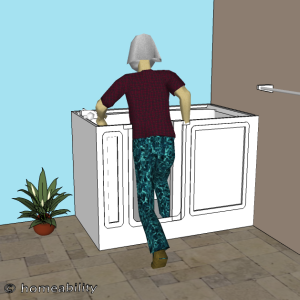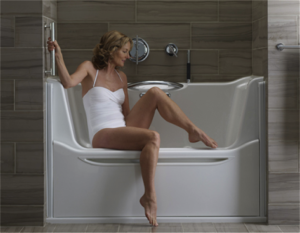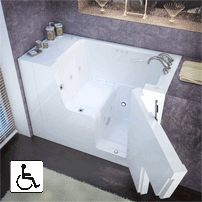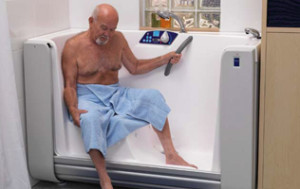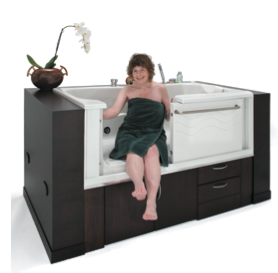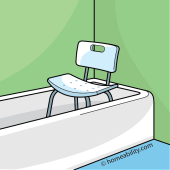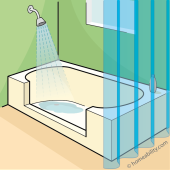Slide-in Bathtubs: The Basics
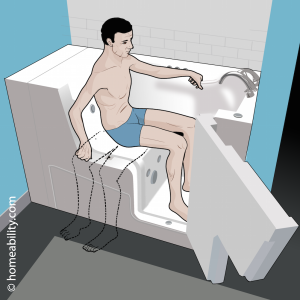
What is a Slide-in Bathtub?
A slide-in tub is a bathtub with a a chair-height surface inside to sit on and a door in the sidewall that permits a bather to enter through the side of the tub. When the door of a slide-in tub is opened, one side of the bath seat is exposed, allowing a bather direct access to the seat inside.
Slide-in Tubs Versus Walk-In Tubs: What’s the Difference?
Before we delve into detail about the different types and features of Slide-in Tubs, it will be helpful for you to be aware that there are two types of tubs that have a door located in the side wall, namely: Slide-in Tubs and Walk-in Tubs. These two tub types are similar in most respects, but there is one critical difference, which is: upon opening the tub door, a user of a slide-in tub has direct access to the seat inside, whereas a walk-in tub user does not. For further clarification, see the pictures and descriptions below.
The guide below provides an overview of Slide-In Tubs and their features. If you would prefer to learn more about Walk-in Tubs, visit our guide titled Walk-in Tubs: Get the Facts.
First: “Why is it Called a “Slide In Bathtub”?
A person who walks has the option to sit down on the side of the bath seat first and once safely seated, pivot their hips to face the front of the tub while lifting one leg at a time over the threshold into the tub. A person who uses a wheelchair can park their chair beside the tub and slide sideways from the wheelchair seat to the bath seat inside.
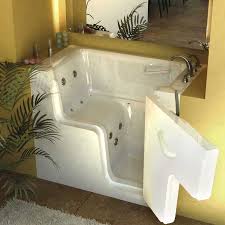 |
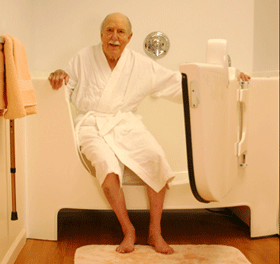 |
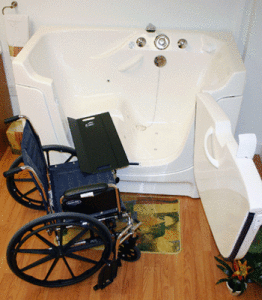 |
| Door opens to expose seat | User Can Sit Down First | Wheelchair accessible |
Types of Slide-in Tubs
All slide-in tubs have one thing in common: a chair-height seat inside that a user can directly access upon opening the door. Slide-in tubs models, however, can differ in a variety of other ways. Two key ways they can differ include: door type and the position the user is in while bathing (sitting up or lying down).
Slide-In Tubs: Seated and Lying Down Types
Slide-In Tubs: 3 Door Types
Door Type: Manual versus Electric
The door on Slide In Tub models differ not only in the direction the door moves (outwards, upwards, or sideways), but also differ in whether the door is manual or electric. Some models have a lever handle that is designed to be opened manually by you, while others have an electric door that opens and closes via the push of a button. Slide-In Tub models with a door that is designed to be opened and closed manually are, in general, a much safer option because there is less than can go wrong. A model with an electric door can be beneficial for some persons with severe physical limitations, but it has inherent drawbacks: a mechanical failure or power outage could prevent the door from opening.
If you do purchase a slide-in tub model with a door that is reliant on electricity, it is advisable to have a caregiver present in the home while you are bathing; to always have a portable phone in reaching distance of your tub , and to also consider purchasing a back up generator or a UPS (Uninterruptible Power Supply) for your home to help ensure you have adequate power to operate the door if the electricity were to go off. You certainly wouldn’t want to be stuck indefinitely inside of the tub during a power outage until the power comes back on!
Slide-in Tubs on Amazon.com
Is a Slide-In Bathtub Right for You?
Slide in tubs are a viable consideration for almost everyone because a bather can choose to transfer into and out of the tub in a variety of different ways. Five ways it is possible to get into and out of a slide in tub are outlined below. Most slide-in tub models will allow you to choose to enter and exit the tub via any of the first four ways listed below. Some slide-in tub models are specially designed to allow for the transfer technique described by #5 below as well.
- STEP IN
Are you able to walk steadily? If so, it is possible to step in and out of a slide-in tub that is designed for seated users. - SIT DOWN FIRST
Do you have difficulty with balance? If so, you have the option to forego stepping in and can instead simply back up and sit down on the seat, just like sitting on a regular chair. Then, once safely seated, you can raise each leg one at a time into the tub. - SLIDE SIDEWAYS
Do you rely on a wheelchair? If so, you can slide sideways from the wheelchair seat to the bathtub seat. - CEILING LIFT
Do you rely on a ceiling lift to assist you with transferring between surfaces? If so, it is possible to install a track on the ceiling above the tub and use it in conjunction with a waterproof sling to transfer into and out of a slide-in tub. - PORTABLE MECHANICAL LIFT
 Does a caregiver assist you to perform transfers using a portable patient lift? If so, some (but not all) slide in tub models can be used in conjunction with a portable mechanical patient lift. Slide in tub models that can be used with a portable patient lift are ones that have a pre-existing space or a panel at the bottom edge of the tub that can be removed to allow the legs of the lift to slide underneath. A hydraulic patient lift can be purchased, which has a lever that is pumped up and down to raise and lower a person. This type tends to be cheapest. Battery operated models are also available that make it easy to raise and lower a person simply with the push of a button. l
Does a caregiver assist you to perform transfers using a portable patient lift? If so, some (but not all) slide in tub models can be used in conjunction with a portable mechanical patient lift. Slide in tub models that can be used with a portable patient lift are ones that have a pre-existing space or a panel at the bottom edge of the tub that can be removed to allow the legs of the lift to slide underneath. A hydraulic patient lift can be purchased, which has a lever that is pumped up and down to raise and lower a person. This type tends to be cheapest. Battery operated models are also available that make it easy to raise and lower a person simply with the push of a button. l
Portable Mechanical Patient Lift Amazon.com
Continue reading below to learn about some of the pros and cons of slide in tubs, as well as other important aspects to take into consideration before opting to purchase a slide in tub.
Slide-in Bathtubs: Pros and Cons
Slide-in Tubs, like nearly everything in life, come with both pros and cons.
Pros:
- Easy Access: This type of tub can make it easier for users of varying ability levels to enjoy a warm, soothing bath.
- Future-Proof: Due to the versatility in transfer styles slide in tubs will allow for, this type of tub can make it possible to enjoy the pleasure of soaking in a hot bath until age 100 and beyond.
Cons:
- Wait Time: You cannot pre-fill a Slide-in tub with hot water prior to climbing in because if you were to, the water would escape when you opened the door to climb in. You must instead first enter the tub and then sit naked patiently waiting for the tub to fill up. At the end of the bath, you’ll likewise have to sit naked and wet patiently waiting until all the water has drained out before you can open the door to exit.
- Higher Utility Bills: If you use the tub regularly, your utility bills will increase due to the amount of water it takes to fill the tub and the electricity required to heat the water.
- Maintenance: The door seal will periodically need to be replaced over the years. And, if the model has an electronic door, then it is reasonably safe to assume that the components will need some intermittent maintenance over the years, as well.
Slide-in Tubs on Amazon.com
IMPORTANT CONSIDERATIONS!
Have you come to the conclusion that a slide-in tub appears to be good a fit for your personal needs? If so, then you’ll need to zero in on identifying a model that is right for you. Following are three of the more important things to take into account as you are scrutinizing the various Slide In Tub models.
1. Door Release Handle
Are you considering to purchase a type of Slide-In Tub that will hold you in an upright seated position (versus the lying-down style)? And, do you plan to bathe independently without a caregiver present? If the answer to both of these is yes, then the location of the tub’s door release handle is a critical detail to take into account. Why is this relevant? The reason it is important is because there have been cases in which adults have slipped down into the footwell of tub’s like these (with high sidewalls and a molded seat inside) and then found themselves unable to get up from the footwell, due to a combination of the small quarters and an inability to open the door.
Slide-in Tubs door release handles are located in different places on different models, i.e. inside the tub door, on the top edge of the tub door, or fixed to the outside of the door. It is reasonably safe to assume that it would be impossible for you to reach a door handle fixed to the outside of the door — if you were to be alone, to slip, and to find yourself sitting inside in the footwell portion of the tub. The location of the tub’s door-release handle, however, is just one important aspect to consider. The manner in which the door release handle is operated (lever-style, swivel, or rotated), along with the force it takes to operate the door release mechanism, will also play a role in whether you’d be able to open the door release handle if you found yourself seated on the tub floor. It is additionally important to take into account your own physical skills as well (i.e. range of motion in shoulders, arm strength) when you are assessing whether you believe you’d be able to escape from a specific slide-in tub model if you were to find yourself alone, sitting on it’s tub floor.
Slide-in Tubs on Amazon.com
2. Drain Position/ Seat Position/ Door Swing
Are you planning to simply replace an existing tub or shower with a slide-in tub (versus doing a complete bathroom remodel)? If so, it is important to select a slide-in tub model with a drain hole that will coincide with the location of your bathroom’s existing drain (or else you will need to invest more money to have the plumbing modified). Most slide-in tub models can be ordered with the drain oriented at the left or the right end of the tub. Are you considering to purchase a type of Slide-In Tub that will hold you in an upright seated position (versus the lying-down style)? If so, as a general rule of thumb, the tub’s seat will be located at the opposite end of the tub from where the drain resides. Prior to ordering such a tub, make sure to assess whether the seat’s location (opposite of the drain hole) will ultimately be located where you functionally want & need it to be, as well as that the door itself will not be impeded from fully opening by other nearby bathroom fixtures.
Slide-in Tubs on Amazon.com
3. Amount of Seat Exposed
As you are assessing the various slide-in tub models, it’s also good to take into account the amount of seat that is exposed when the tub’s door is opened. On some slide-in tub models, when the door is opened, one side of the seat is nearly fully exposed, while on others a smaller percentage of the seat is exposed. As a general rule of thumb, the more seat that’s exposed and readily accessible, the better, because it provides a larger sitting surface, making it easier for a user who can walk to sit down on the side of the seat first, then lift one leg at a time over the threshold and into the tub. It likewise makes it easier for someone unable to walk to slide from their wheelchair’s seat over onto the tub’s seat.
Slide-in Tubs on Amazon.com
Water Jet System, Air Jet System, or Soaking Tub?
Some, but not all, slide-in bathtubs can be ordered with a water jet system, air jet system or as a basic soaker tub. The following are pros and cons for each.
1. Water Jet System (also known as Whirlpool, Nano, or Hydro Massage)
- Pro: Jets provide a strong water flow that can provide a massage-like effect for aching muscles and joints.
- Con: The water pressure may feel too strong for persons with fragile skin.
- Con: Water is recycled through the system, so the use of oils, scents, soaps and shampoos typically isn’t recommended.
- Con: Residual water left in the water jet system has potential to grow mold or bacteria, which poses a health risk for individuals with a compromised immune system, respiratory problems or susceptibility to pneumonia. A model that additionally offers a self-purging feature may help to reduce the likelihood of bacteria growing in the lines.
2. Air Jet System
- Pro: The air jet system creates a gently bubbling bath giving a bubble bath effect.
- Pro: Water does not recycle through an air-jet system, so you can potentially use some types of oils, scents and soaps in the water. Confirm with the manufacturer which, if any, products can be used.
- Con: Although water does not get recycled through the lines, there is still a possibility for mold and bacteria to grow. Experts recommend running the air jets after the tub is empty to help dry the tub and reduce the risk of mold and bacteria growth inside the lines.
- Con: The air bubbles do not provide a massage-effect like the water jets do.
Some companies offer tubs which provide both air and water jets. This option can often be found advertised as “Dual Massage.”
3. Soaker Tub
- Pro: Less expensive than air and water jet systems. This type is equivalent to soaking in a hot bath in a standard bathtub.
- Pro: Soaps, oils and shampoos can all be used (unless otherwise specified by the manufacturer).
Slide-in Tubs on Amazon.com
Slide-in Tubs on Amazon.com
Tub Frame Type & Material
The tub frame can be made of wood, aluminum or stainless steel, with stainless steel being the strongest of these three options. The molded exterior layer of the bathtub can be made out of acrylic, fiberglass, or sometimes a combination of the two. Some of the pros and cons for acrylic and fiberglass tubs are described below.
- Fiberglass Tubs: Fiberglass models tend to be less expensive than acrylic tubs. Fiberglass is a strong, durable material, but in comparison to acrylic, it is more porous making it more prone to stains, scratches and cracking than acrylic tubs and also more prone to losing the color and glossy finish with time.
- Acrylic Tubs: Acrylic tubs are said to be more durable, color-fast, and better at withstanding cleaning and wear and tear over the years than fiberglass models. If, however, an acrylic tub is scratched or chipped, it is said to be more difficult to repair a blemish to make it look like the original surface, than with a fiberglass tub.
Slide-in Tubs on Amazon.com
Slide-in Tubs: More Important Considerations!
- User Height: If you are extremely tall, the slide-in tub models that are designed to support a person in an upright seated position are probably not an ideal solution, unless your main intent is to soak from your waist down.
- User Weight: Confirm the maximum weight limit is appropriate for your needs, prior to ordering.
- Seat Height The seats have a fixed height, which can vary from model to model, so make sure to confirm the seat height of the model you select is suitable for your needs. If you will be transferring from a wheelchair, the height of the tub seat should match the height of your wheelchair seat as closely as possible to allow for an easier transition between surfaces.
- Tub Size: The salesperson may try to tell you a ‘larger tub is better’, but keep in mind that the larger the tub, the longer it will take to fill and empty.
- Drain Height: Make sure to ask how high the overflow drains sits above the seat, especially for a seated model. In some cases it can be rather low, meaning the water may only fill to about your waist level, which is probably not what you had in mind when you set off to buy a bathtub for a nice, fully submerged soaking experience.
- Drain Control: Confirm how the drain system itself works. Does it have a chain and stopper combination that you would need to be able to reach down to the floor to operate or does it have a knob or a button to push, which can be accessed from a seated position?
- Time to Fill and Empty: Models will vary in the time it takes to fill and empty, but on average it will require 6-15 minutes to fill and empty depending on your home’s water pressure and plumbing. Some manufacturers offer a high flow faucet feature for helping to fill the tub more quickly and an enhanced drain system for helping to empty it more quickly. Note that your home’s existing water pressure and piping system will affect the filling and draining speeds, so it is possible that no matter what you add it may still fill and drain slowly.
- Handheld Shower Head: Some models automatically include a handheld shower head, while others require you to purchase it separately. It is beneficial to have a handheld shower head, because it allows you to start showering while you are waiting for the tub to fill.
- Water Retention:If you plan to use a handheld adjustable showerhead, consider installing a shower curtain around the upper portion of the bathtub to help contain the water.
- Consult With Your Doctor: If you have a chronic medical condition, you should talk with your medical doctor prior to purchasing a slide-in bathtub to ensure it is not contraindicated for your medical diagnosis.
Slide-in Tubs on Amazon.com
What is the Cost of a Slide-in Tub?
Installing a slide-in tub will cost on average between $5-$20,000. This includes the cost of the tub and installation. Models with a door that can be opened manually tend to be cheaper. Models with electric doors tend to be more expensive.
If you are on a fixed budget, make sure to also factor in the following potential costs when you are deciding whether or not to buy a slide-in tub.
- Water Heater: Confirm that the size of your water heater can support the higher water demands of the slide-in tub. If it cannot, you will need to replace your water heater. This can cost on average $800-$2,000.
- Does it fit?!: Confirm that the dimensions of the tub you select will fit through all the doorways and hallways between the outside of the home and the bathroom. If it does not, you will need to pay to have one or more of the doorframes removed and reinstalled to get the bathtub into the bathroom.
- Structural Support: Your bathroom floor may require extra structural support to manage the weight of the tub.
- Electrical & Plumbing: It is likely that you will need to have your electrical or plumbing modified to support the tub.
- Maintenance: The door seals and/or other parts will require maintenance over the years.
- Utility Bills: Your monthly water and electric bills will increase.
- Heat Lamp: It can be cold at the beginning and end of the bath while waiting for the tub to fill and empty. You may want to consider adding a heat lamp on the ceiling above the tub to help you stay warmer during these times.
Will Insurance Cover a Slide-in Style Bathtub?
Do Your Research!
Check for Certifications: One or more of the following certifications indicates the tub has passed certain minimum accepted functional and safety standards: IAPMO (UPC), ASME, or CSA certification.
Check Reviews: Prior to making your final decision on a tub model, check both the bathtub model and the manufacturer’s name online in conjunction with the word “reviews,” “complaints,” and “scams,” to ensure that there isn’t a negative review history. Be aware that researching these tubs can be quite difficult because the accessible bathtub industry is notorious for having some dodgy review websites. We recommend you educate yourself about some of the scams and shady practices going on in the accessible bathtub industry to help best ensure you don’t fall prey to them. To learn more, click here.
Who Can Benefit from a Slide-In Tub?
A Slide-in Tub is beneficial for persons who…
- cannot step over the wall of a standard bathtub or
- want to take a soaking bath, but can’t get up from the bottom of a standard-style bathtub.
The Homeability Advice™ 
Regardless of the type of tub you choose, we recommend you always have a portable phone in reaching distance of your tub just in case there is a mechanical failure. Or better yet, consider installing a phone permanently on the wall beside the tub to prevent needing to remember to bring a phone into the bathroom with you every time you bathe.
Is your primary goal to soak in a bathtub or to bathe independently? If it is the latter an even more future-proof bathing solution is a curbless shower. They are easy to enter and exit for all users making them a great future-proof bathing solution. If you long for the whirlpool jets, you can further enhance the shower experience by adding jacuzzi-style shower jets in the shower wall at your back level to provide a massage-like effect. To learn more, visit our article: Curbless Showers – A Great Age-Proof Bathing Solution
More Topics You May Be Interested In

